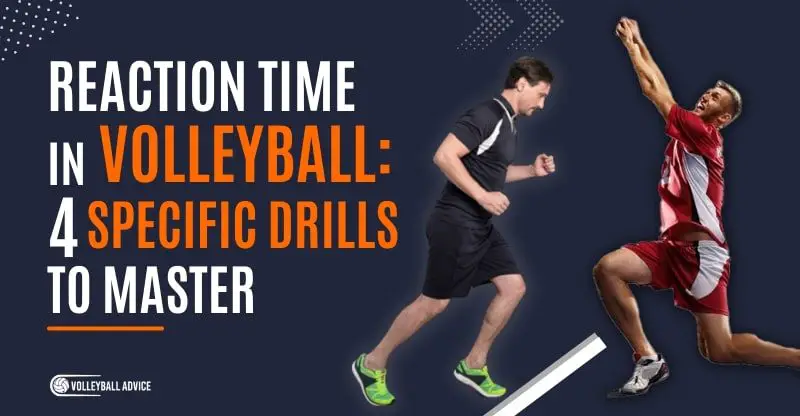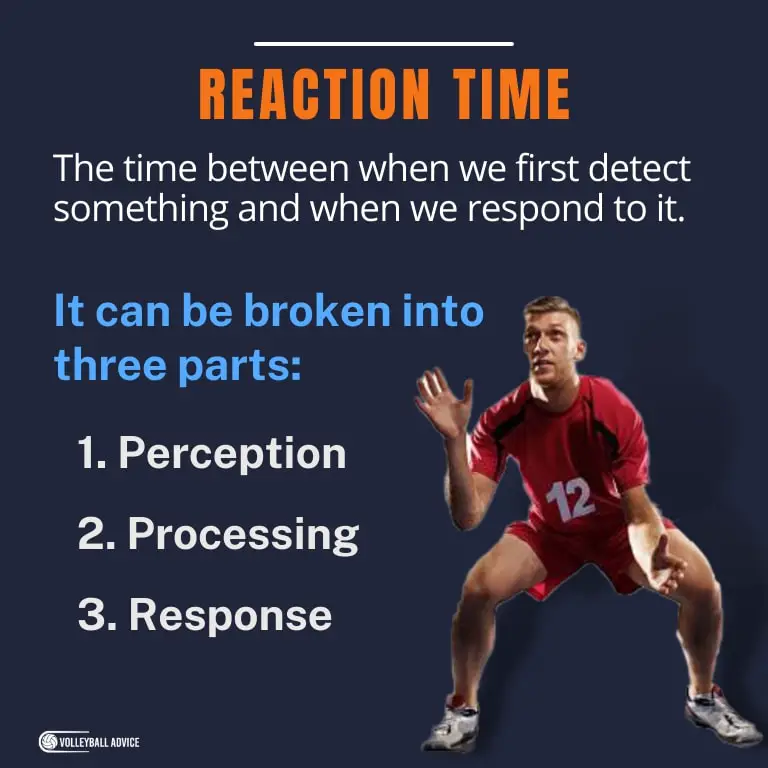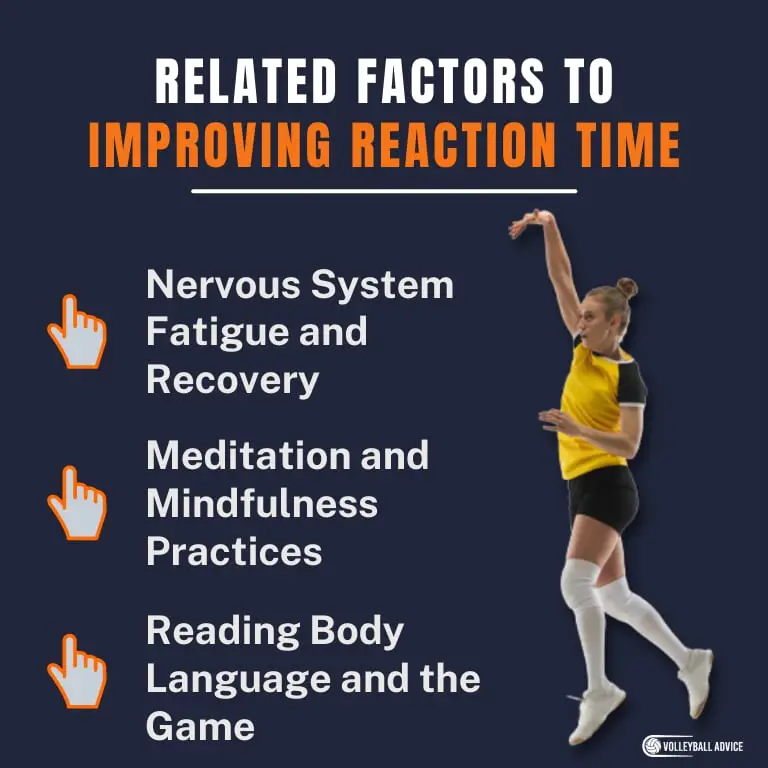Reaction Time in Volleyball: 4 Specific Drills To Master
In volleyball, reaction time can be the difference between you moving to hit the ball and the ball hitting you.
So how do you improve reaction time in volleyball? You can improve reaction time in volleyball by training yourself to have better detection of what’s happening on the court, mostly through your visual system (what you perceive with your eyes), and then having faster decision-making abilities. As well, improving your overall athleticism will improve reaction time.
Below I will break down the components of reaction time, other factors to consider and some simple drills that can be incorporated into your training.
Defining Reaction Time in Volleyball
Reaction time is the time between when we first detect something and when we respond to it.
It can be broken into three parts: (1) perception, (2) processing, and (3) response.
1. Perception
Our senses (seeing, hearing, feeling), all provide information to the brain about the stimulus.
Being certain about this stimulus is an essential part of reaction time as we can then process and make a decision based on what we have detected.
An example in volleyball would be hearing the contact with the ball and seeing the first few milliseconds of direction, will help decide where on the court we need to be to defend it.
For most sports the main sources of stimulus or detection are visual (what we see) and auditory (what we hear).
Games, softwares, and tools can be used to train the visual system to better detect what’s happening on the court. This can also be done for hearing and your other senses.
2. Processing
Processing of a stimulus is about understanding what it is we detected with clarity, distinguishing it from other stimulation, and choosing a response.
In volleyball this can be having confidence you’ve seen the ball coming toward you, processing whether or not it will land in the court, and whether it will come close enough to you for you to pass it.
There are a growing number of cognitive training tools that can be used to target the areas of the brain responsible for processing information and decision making.
These do include action video games. However, when playing video games it’s important to still consider how the amount you play can impact your physical and mental health and the overall impact it can have on your performance.
3. Response
Reflexes and reaction time are sometimes confused as they both create quick movement. There is an important difference though.
The signaling of movement from reflexes do not come from the conscious part of the brain.
The movement in reaction time is created through conscious decision making after the processing stage.
After the response is chosen, the ability to execute the movement is based on coordination, balance, and speed.
Related Factors to Improving Reaction Time
Nervous System Fatigue and Recovery
Just like muscle, the nervous system, meaning your nerves and brain, can fatigue.
Training reaction time is for the most part training of the nervous system as it’s responsible for the signals traveling to the brain, based on the stimulus detected, the processing in the brain, and the signals to the muscles to create movement.
For nerves to grow and signals to travel through the nerves, there are many chemical reactions that must happen. Hydration, nutrition and sleep can all aid or disrupt these reactions.
There is plenty of research on how sleep deprivation, meaning lack of or poor quality sleep, can affect cognitive ability and reaction time. Because of this, studies show it can affect passing accuracy in volleyball players up to 16%.
Adequate sleep, not only helps keep your reaction time as fast as possible, but also helps grow new nerves. This is why it is such an important part of recovery.
Water, alcohol, salts, and food all play a role in the chemical reactions that help nerves grow and function properly too. So, what you are putting in your body can decrease or help improve your reaction time.
Meditation and Mindfulness Practices
Another lifestyle related way to enhance reaction time is mindfulness exercises and meditation.
When meditation was practiced for 20 minutes per day ongoing, visual reaction time was shown to decrease 14-19% after 45 days and 19-20% after 90 days. Auditory reaction time was shown to decrease 22-24% after 45 days and 25-30% after 90 days.
Regular meditation practice is also linked to increased thickness in areas of the brain associated with processing, internal and external stimuli such as auditory visual stimulus, touch, temperature, body position (proprioception) and pain.
This increased thickness can translate to increased function of these areas critical for processing the stimulus that we want to respond to.
Reading Body Language and the Game
Reading body language and the game are key parts to anticipation in any sport.
Anticipation through preparation and expectation is important as it can aid in the decision making process, eliminating options and preparing you for the most likely response needed.
Examples of this could be reading the block of the opposition when attacking. On defense, understanding what parts of the court are protected by the block can also help you decide where you are more likely to have to cover.
Understanding this before the ball is hit helps your brain use probabilities and process of elimination to make faster choices in the processing of the stimulus.
Reading the game and body language helps improve familiarity. This familiarity, responding to a stimulus that you’ve responded to before lowers reaction time.
This means practice and game time will help with reaction time as the brain will recognize situations that it’s seen before and need to process less information before responding.
Criteria for Improving Reaction Time in Volleyball
Reaction time can be improved through enhancing abilities in perception, processing, or response.
When assessing how useful a drill may be, there are a few things to keep in consideration.
As mentioned above, familiarity lowers reaction time. For example exposure to different serve types will help with recognition of the type of serve and how to respond.
When choosing drills, consider if it is practicing a movement required in volleyball or visual stimulus common in volleyball.
Another consideration is the type of stimulus.
In volleyball primarily the stimulus is visual as you need to see where the ball is going. However there are some auditory cues, such as hearing ball contact and directions from teammates.
Because of this it makes sense to primarily use visual cues in reaction time drills.
Stimuli can also be divided into 3 categories: simple, choice, and selection:
- In simple stimuli there is one response to a single stimulus. An example of this is a start gun for a race.
- In choice stimuli there are different responses to different stimuli. An example is choosing where to hit based on the block.
- In selection stimuli there are different stimuli but you only have to respond to one. An example of this is back row defense, you only have to respond if the ball is hit towards you.
In a volleyball game most stimuli would be in the choice and selection categories. Therefore, it makes sense that most of reaction time training is done with this type of stimulus.
Simple stimuli drills like fast feet can still provide an effective warm up before starting more complex drills and are also a great entry place for players who have never done coordination and agility work before.
Because reaction time drills require a lot of mental processing, they are highly demanding on the nervous system. For this reason the drills below are intended to be done with high intensity for short periods followed by a rest period.
Reaction Time Drills for Volleyball
While visual and cognitive training tools, softwares and games are becoming more available, there are also ways to improve it that only require a partner to do drills with.
Agility drills where the Stromectol response is to more volleyball specific visual cues, like serve a ball hit near but not to you, are other ways to improve reaction that allow you to work on familiarity.
However drills that would allow you to also work on reading body position require a partner to have the volleyball skills to execute and mimic a game setting.
The drills below do require a partner but do not require your partner to have volleyball skills.
1. Fast Feet Over and Back
This drill is a simple stimulus to an auditory cue to “Go” or a visual cue as well as builds coordination and repetition of quickly moving the feet in response to a stimulus. Because it is a simple stimulus it is a good entry level drill.
How To
- Stand behind a line
- When someone says “Go” or visually cues (raises hand for example), step over the line and back as fast as you can
- Continue for 5-10s then rest
- Repeat the next time you are told to “Go”
- Repeat this cycle for 3 sets.
Pro Tip
Start in an athletic stance and keep the upper body relaxed as you move.
2. Race to the Floor
This is a visual reaction time drill that includes some arm torso and leg movements. It is an example of choice stimulus as it has multiple options for responses. Race to the Floor is more complicated than Fast Feet.
How To
- Stand across from a partner who has a ball (tennis ball sized or smaller) in each hand and arms out at shoulder height
- The partner will drop either or both balls
- Catch the ball or balls before they hit the floor
Pro Tip
Anticipate pulling yourself into a squat to give yourself more time to catch the ball.
3. Single Bounce Ball Drop
This would be a progression of the Race to the Floor as now the response requires sprinting off a line.
How To
- Stand 1m from a partner who has a ball (tennis ball sized or smaller) in their hand and their hand shoulder height out beside them
- Stand in an athletic or serve receive stance
- Run towards the ball when it is dropped and catch it before the second bounce
- This can be made more difficult by having the ball dropped father from the start line
- A second progression would be to have 2 balls one in each hand and arms out to either side.
Pro Tip
If this is not previously practiced, it is common for people to take a first step slightly backwards to reposition the feet and torso into an angle to accelerate. Work on initiating movement from the torso and having your first step out of the athletic stance be forward.
4. Triangle or Square Agility
This is a multi direction agility drill that takes the skills learned in Sprint Workouts for Volleyball and adds a stimulus to respond to.
This drill can be made easier or more difficult by adding responses, going from 3 cones to 4 or adding complication in the stimulus.
Examples of auditory cues for the cones could be 1, 2, 3, A, B, C, Red, Green, Blue. Visually the coach or partner can point at the cone to touch.
Asking more of the processing stage of reactions can be done by mixing or adding cues. For example, using auditory or visual cues, or using 1, 2, 3 and A, B, C.
Another progression could be to use multiple cues, some of which are to be ignored and some responded to.
How To
- Set up cones in a triangle and assign them cues (1, 2, 3 for example)
- Stand in the middle of the triangle and touch the cone that is called out
- Return to the middle between each cone touch
- After 5-10 cones are called take a rest
Pro Tip
This drill can also be done in pairs with one person mirroring as close as possible to the other.
Sample Program
Agility and reaction time exercises are best done between a warm up and power exercises in a work out or between generic warm up and skill specific warm up on court.
Once the cardiovascular system and muscles are warmed up, the nervous system can be engaged with some fast feet followed by a few sets of the following drills.
- Fast Feet Over and Back – 5s x 2-3 sets
- Race to the Floor – 5 drops x 2 sets
- Single Bounce Ball Drops – 5 drops x 2 sets
- Triangle Agility – 5 cones x 2-5 sets
Final Thoughts
Reaction time involves perception, processing and responses to stimuli. All 3 of these areas can be trained to improve reaction time.
The drills given are easy ways to work on perception and processing while also improving the ability to move around the court.
About The Author
Ian started his strength and conditioning career working with elite youth volleyball athletes. Before coaching, he completed a BSc in Biomechanics at the University of Calgary. He has over a decade of experience working as a kinesiologist and strength and conditioning coach, with teens to octogenarians in positions with community gyms to elite sport. Outside of coaching, you can find Ian learning new sports, skiing, river surfing, hiking, and traveling. If you have questions or are interested in opportunities to work with Ian, connect with him via Instagram, Linkedin, or Website.



